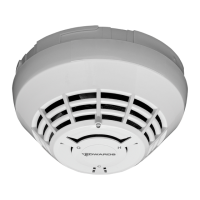P/N 3102362-EN • REV 01 • ISS 06APR16 1 of 2
SIGA-PD Intelligent
Photoelectric Smoke Detector
Installation Sheet
Description
The Signature Series model SIGA-PD Intelligent Photoelectric Smoke
Detector is an intelligent device that uses an optical sensing chamber
to detect smoke. The detector analyzes data from the sensing
chamber to determine whether to initiate an alarm.
LED indicator. The LED indicator (see Figure 1 below) displays the
following states:
• Normal: Green LED indicator flashes, no action.
• Alarm/active: Red LED indicator flashes, evacuate the area.
Figure 1: SIGA-PD features
2
(1) Self-locking tab
(2) LED indicator
Installation
Notes
• This detector does not operate without electrical power. As fires
frequently cause power interruption, discuss further safeguards
with the local fire protection specialist.
• This detector does not sense fires in areas where smoke cannot
reach the detector. Smoke from fires in walls, roofs, or on the
opposite side of closed doors may not reach the detector.
• Photoelectric detectors have a wide range of fire-sensing
capabilities and are best suited for detecting slow, smoldering fires.
• To ensure proper operation, store the detector within the
recommended ranges. Allow the detector to stabilize to room
temperature before applying power.
• The dust cover (supplied) must remain on the detector during
installation and be removed prior to commissioning and service.
The dust cover is not a substitute for removing the detector during
new construction or heavy remodeling.
• Do not use smoke detectors with detector guards unless the
combination has been evaluated and found suitable.
• In Canada, install according to CAN/ULC-S524 Standard for the
Installation of Fire Alarm Systems, CSA C22.1 Canadian Electrical
Code, and the local authority having jurisdiction.
• Upon completion of the original installation and following any
modifications or additions to the system, perform a calibrated
sensitivity test per NFPA code. The Signature Series devices can
perform this test and the panel can generate a system sensitivity
report.
To install the detector:
1. Install and wire the base, as described on the installation sheet
supplied with the base.
2. Remove the serial number label from the detector and attach it to
the project documentation.
3. Attach the detector to the base by rotating the detector clockwise
until it snaps into the locked position.
Testing
Before testing, notify the proper authorities that the fire alarm system is
undergoing maintenance and will be temporarily out of service.
To perform an initial installation test:
1. Remove the detector from its base and verify that the proper
detector address, trouble signals, and messages are reported.
2. For SIGA-PD detectors placed in the air ducts, verify that the
airflow is within specifications. See “Specifications” on page 2.
3. If wired for Class A operation, verify that the detector continues to
operate first with SLC_IN disconnected, and then with SLC_OUT
disconnected. (Refer to the installation sheet for the base.)
4. Place a momentary ground fault on the SLC circuit to verify
operation of ground fault detection circuitry.
5. Run a system detector sensitivity report on all detectors and verify
that the readings fall within acceptable limits.
6. Perform a sensor function test, as described below.
To perform a sensor function test:
1. If desired, use the fire alarm control panel to put the detector or
zone into a service group for testing. (Refer to the panel technical
reference manual for instructions.)

